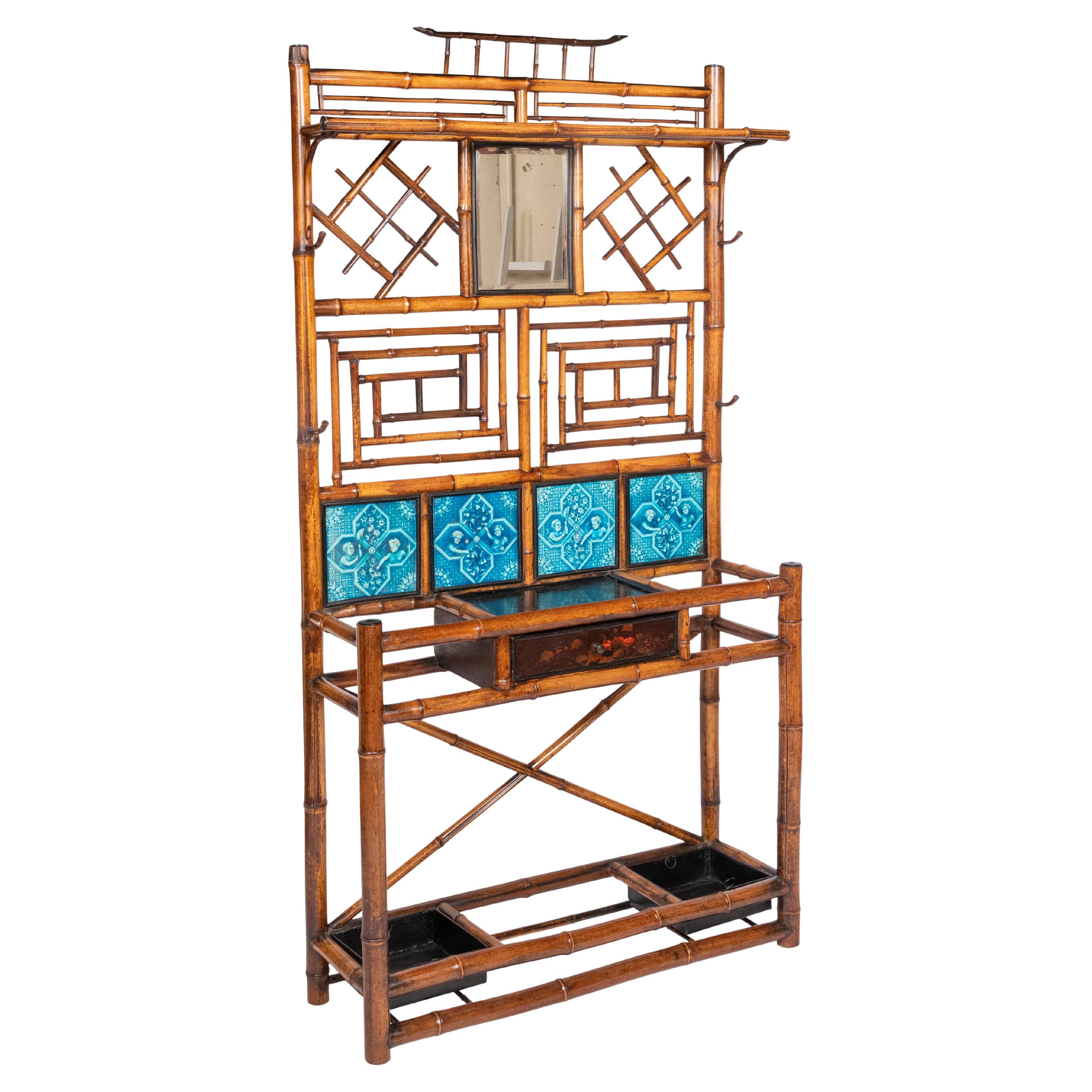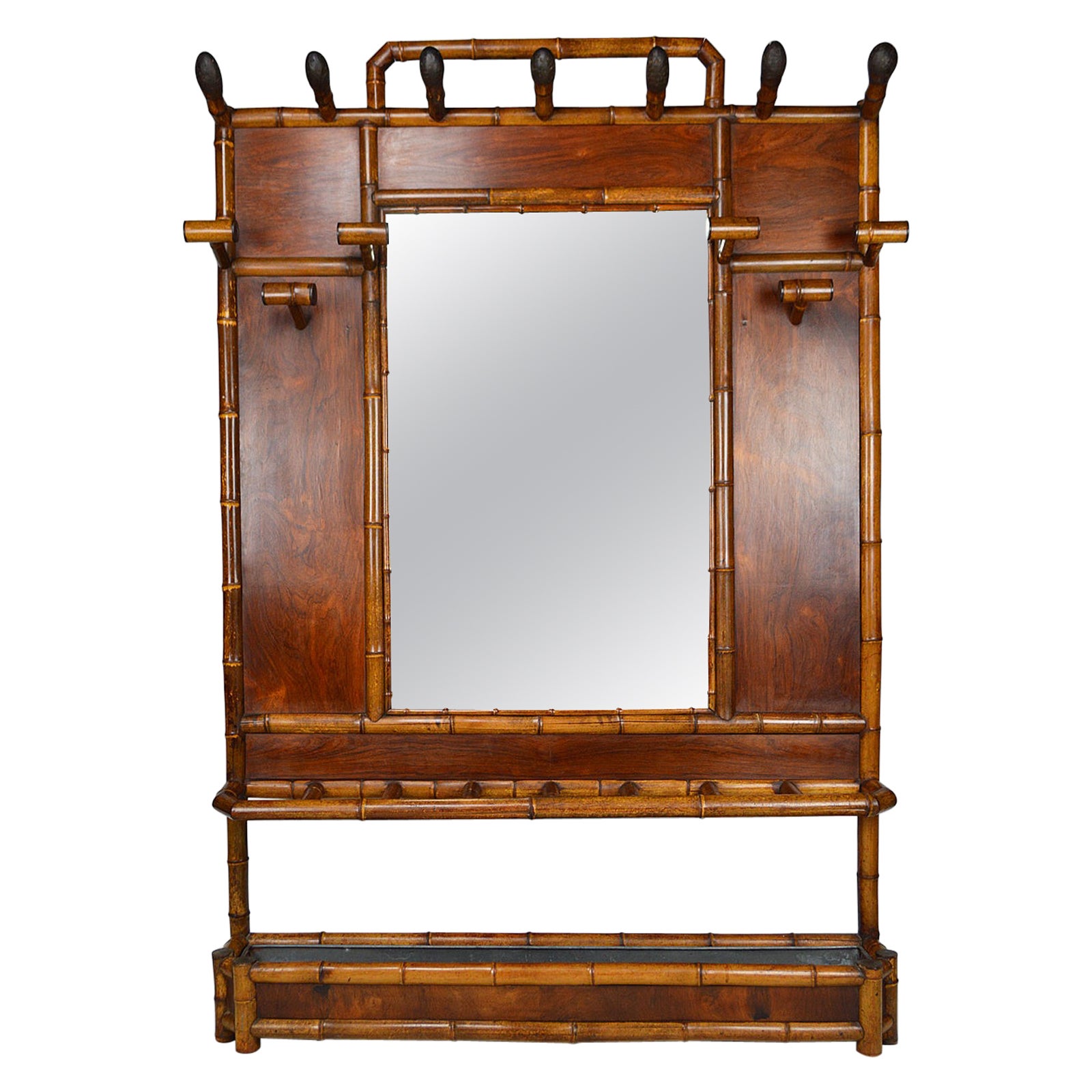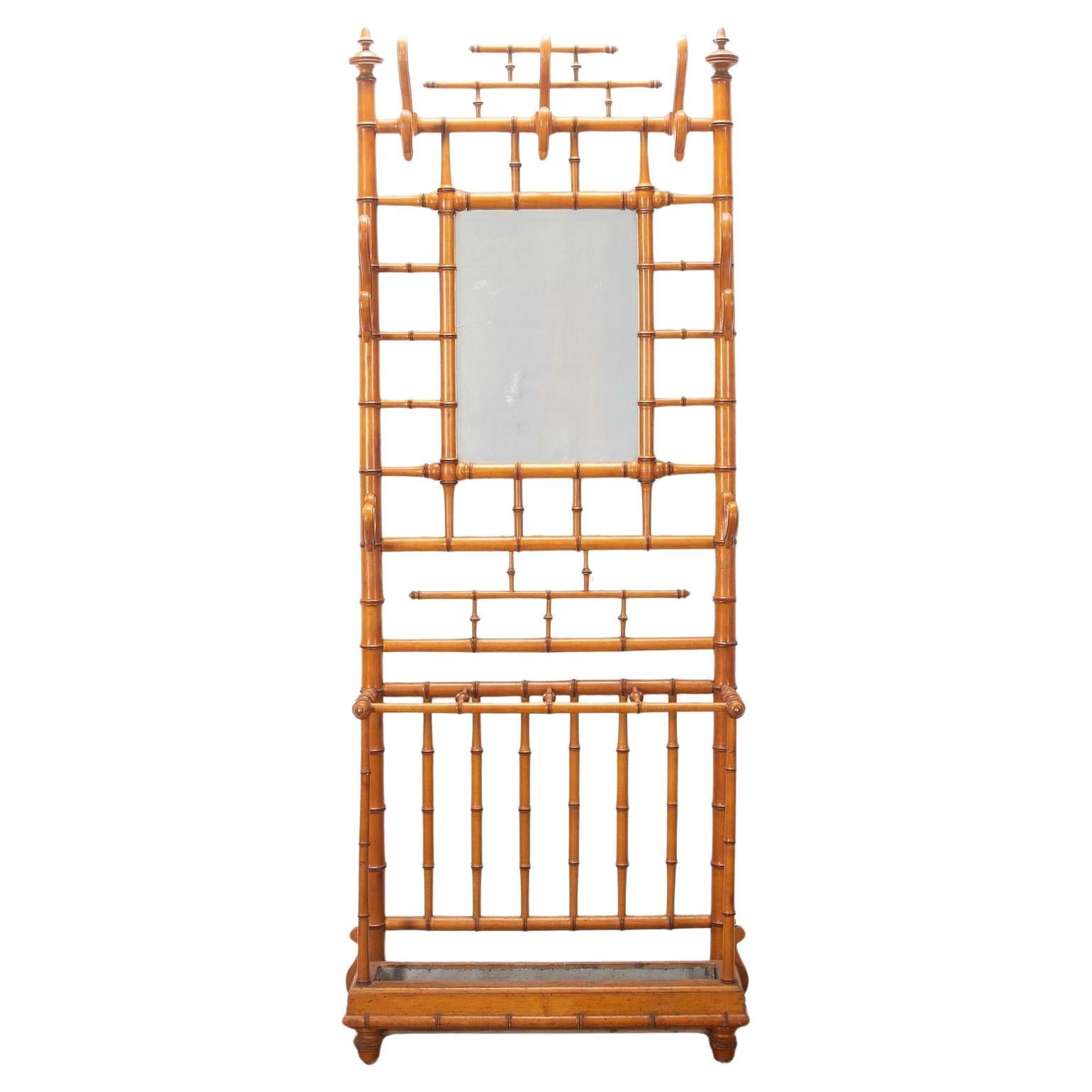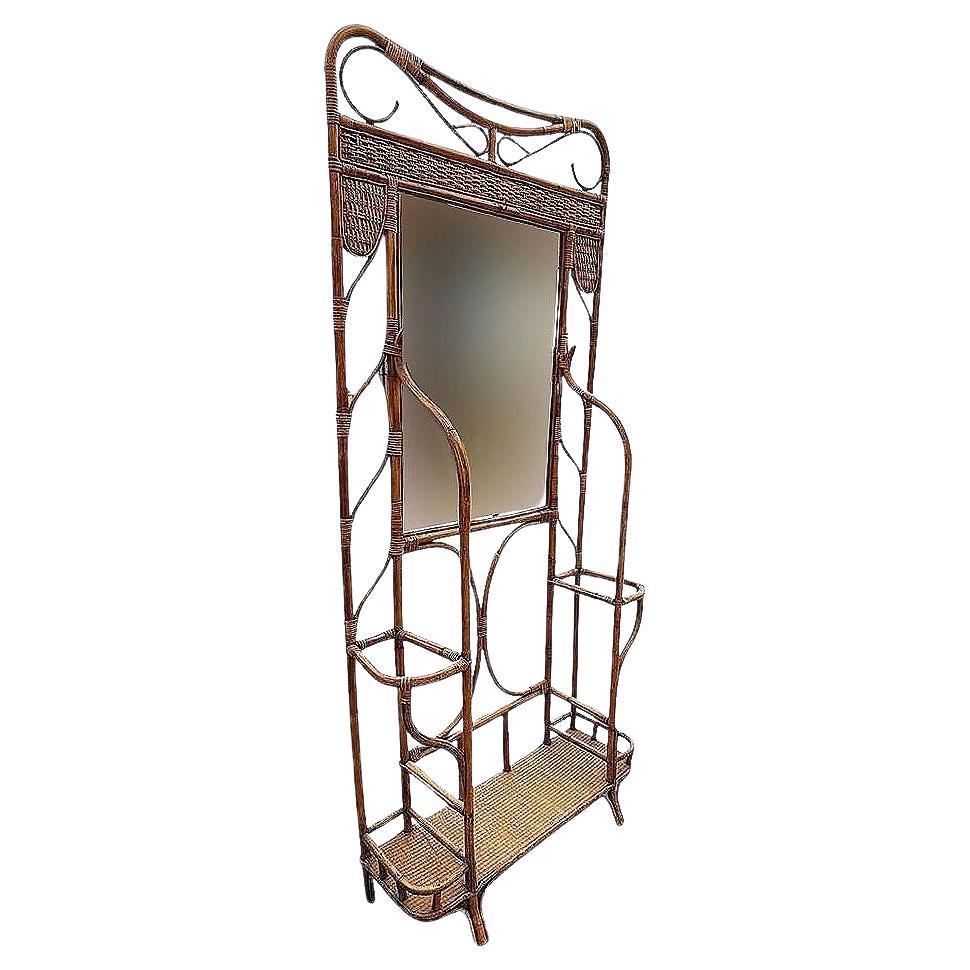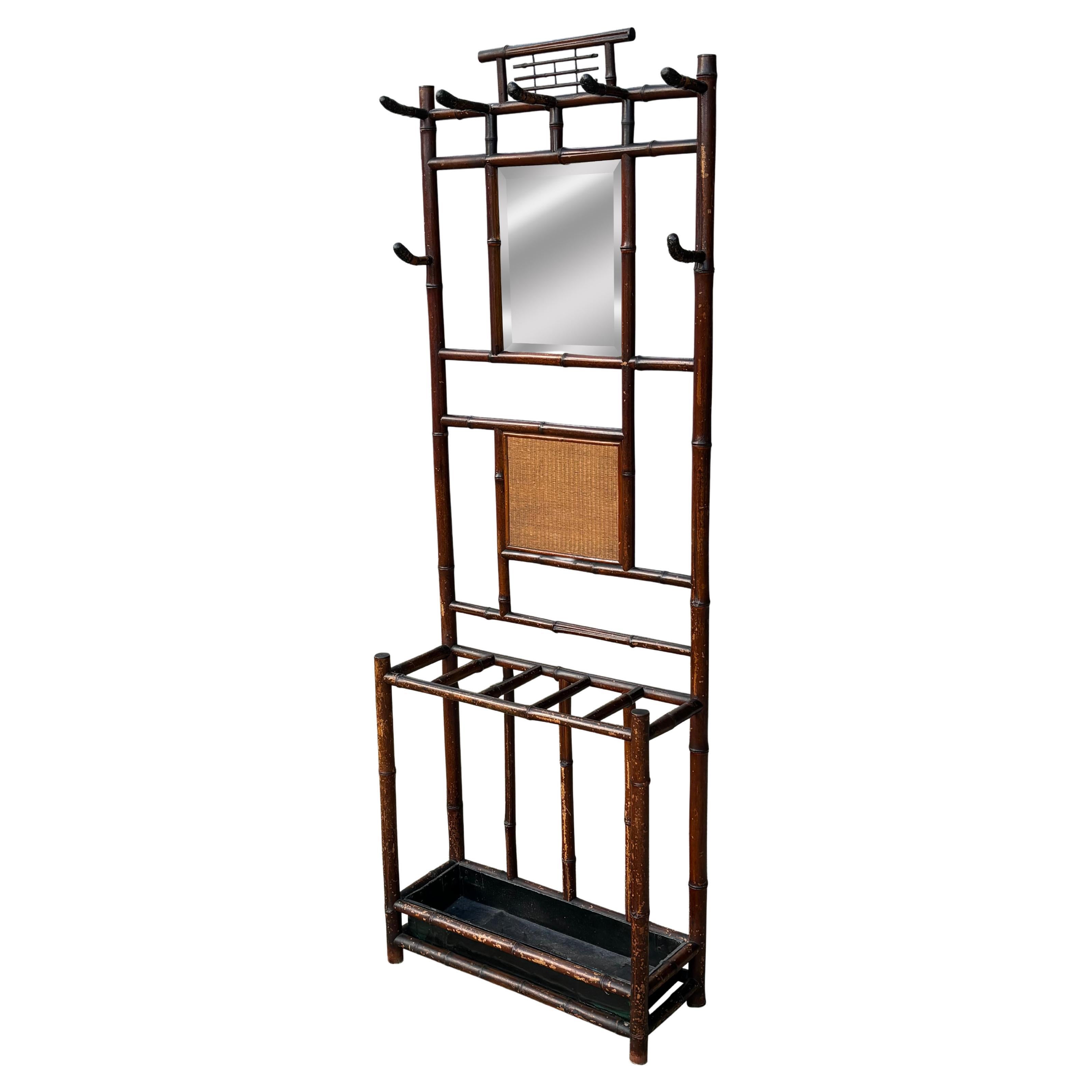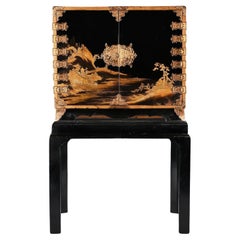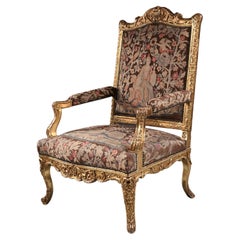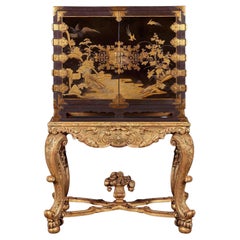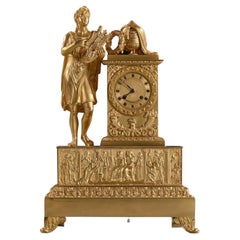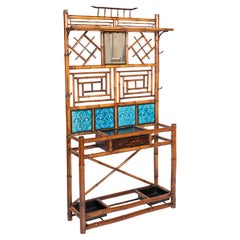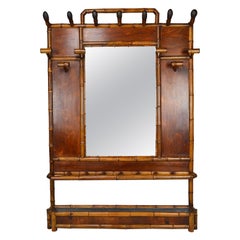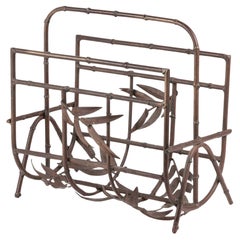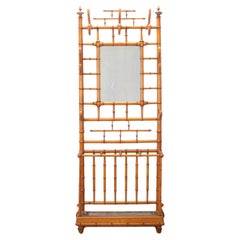Items Similar to French Aesthetic Period Japonisme Birdseye Maple Faux Bamboo Hall Stand
Want more images or videos?
Request additional images or videos from the seller
1 of 7
French Aesthetic Period Japonisme Birdseye Maple Faux Bamboo Hall Stand
About the Item
Wonderful Quality French Aesthetic Period “Japonisme” Faux Bamboo Hall Stand of Grand Proportions with Central Mirror
French Circa 1890
Of broadly rectangular form, this fine piece of hall furniture includes a large central mirror and the usual array of hat holders, a stick stand with removable drip tray and coat hooks, the top being framed by a fine triangular pediment. The mirror is a later distressed plate.
During the late 19th century craze for Japonisme (or Japanese-influenced orientalism) faux bamboo furnishings and even pieces in that style made in cast iron became popular and many hall stands were produced in this vein. The scale and sheer quality of the carving on this example set it apart from other examples of its type, as does the intricacy of the pattern formed by the faux bamboo mouldings. The burr veneers used for the body of the piece set off the “bamboo” work beautifully and the survival of the original large central mirror plate is remarkable given the heavy use the piece would have endured in the past.
A piece of this scale could only have been intended for the very grandest of houses and would almost certainly have been produced as a bespoke commission given the unusually wide proportions. The mellow colour makes this piece all the more attractive and versatile-it would grace either a contemporary or more traditional interior equally well. A truly magnificent example of its kind that would make a wonderful first impression upon arrival for any guest in one's house.
- Dimensions:Height: 76 in (193.04 cm)Width: 61.5 in (156.21 cm)Depth: 9 in (22.86 cm)
- Style:Japonisme (In the Style Of)
- Materials and Techniques:Birdseye Maple
- Place of Origin:
- Period:
- Date of Manufacture:Circa 1890
- Condition:Wear consistent with age and use.
- Seller Location:Benington, GB
- Reference Number:Seller: 29391stDibs: LU1183235714912
About the Seller
5.0
Vetted Professional Seller
Every seller passes strict standards for authenticity and reliability
Established in 1969
1stDibs seller since 2015
124 sales on 1stDibs
Typical response time: <1 hour
Associations
LAPADA - The Association of Arts & Antiques DealersThe British Antique Dealers' Association
- ShippingRetrieving quote...Shipping from: Benington, United Kingdom
- Return Policy
Authenticity Guarantee
In the unlikely event there’s an issue with an item’s authenticity, contact us within 1 year for a full refund. DetailsMoney-Back Guarantee
If your item is not as described, is damaged in transit, or does not arrive, contact us within 7 days for a full refund. Details24-Hour Cancellation
You have a 24-hour grace period in which to reconsider your purchase, with no questions asked.Vetted Professional Sellers
Our world-class sellers must adhere to strict standards for service and quality, maintaining the integrity of our listings.Price-Match Guarantee
If you find that a seller listed the same item for a lower price elsewhere, we’ll match it.Trusted Global Delivery
Our best-in-class carrier network provides specialized shipping options worldwide, including custom delivery.More From This Seller
View AllAn Important Late 17th Century Japanese Lacquered Cabinet Edo Period on Stand
Located in Benington, Herts
An extremely fine, elegant and rare late 17th Century Japanese lacquer cabinet, from the Eco period, on later lacquered black stand.
Japanese circa 1690
Provenance
A private Scottish collection
This outstanding cabinet is a fascinating fusion of east and west. The cabinet itself would have been made in Japan, c.1690, and is decorated to the outside with hiramaki-e lacquer. This technique involves the use of sprinkled gold powder which adheres to the lacquer surface. On the best pieces, as with this example, many layers are added in order to create areas of high relief and give depth to the surface decoration. The taste of the Japanese workshops in this period was often for quite restrained pieces with plenty of the black background visible, unlike some of the busier Chinese lacquer or European japanned examples produced around the same time. The Japanese makers seemed content to rely on the outstanding quality of the lacquer itself, regarded by most experts as the finest lacquer ever produced, and did not see the need to cover every surface believing that less was more in this respect. The lacquer here is used to produce a mountainous scene with buildings on the bank of a river, the other side of the river with more buildings and a contrasting flatter and forested landscape. The fine perspective achieved is the result of the clever use of raised and flatter areas in the lacquer itself in combination with the drawing of the design itself.
Another remarkable aspect of this piece is the fine metalware throughout, but particularly the lockplate / hasp, hinges and foot mounts to the front. This is all beautifully cast and engraved contrasting against the black background. Interestingly another cabinet on stand with near identical metalwork was advertised in the Burlington Magazine, November 1913, with the dealer W. Williamson and Sons of Guildford. The lacquer on that piece is similarly refined and it seems likely that both pieces came from the same workshop.
The European influence in our piece can be seen in both the later ebonised stand and in the japanned decoration which has been applied to the inside of the doors and is also very fine indeed. This consists of two panels with birds of prey perched on branches in colours set against a golden background. The cabinet has a recent Scottish provenance and so it is likely that the ebonised stand was made in Britain though such pieces were made throughout Europe as a way of quite literally elevating these imported pieces of eastern lacquer as in Japan these would have been used on the floor. Inside the cabinet there is a combination of more Japanese lacquer and lock plates and European drawer handles. Most of the lacquer drawer fronts incorporate mountainous scenes and birds in combination, with a few purely one or the other of the two subjects. Again the lacquer is in excellent condition and is of exceptional quality with multiple layers of relief used in one single scene in many cases.
As mentioned above, Japanese lacquer is the most technically brilliant of the eastern lacquers and, as such, was highly prized by collectors and connoisseurs throughout Europe when this piece was made. The acquisition of such pieces would only have been possible for a small group of incredibly wealthy individuals, largely royal or high ranking courtiers or merchants connected with the East India trade...
Category
Antique 1690s Japanese Edo Cabinets
Materials
Lacquer
Fine 18th Century French Regence Period Giltwood Armchair Fauteuil
Located in Benington, Herts
A highly impressive rare French carved Régence period giltwood fauteuil / armchair of imposing proportions with needlework upholstery.
French - circa 1715
Of grand scale, this ...
Category
Antique 1710s Armchairs
Materials
Giltwood
17th Century Japanese Lacquer Cabinet On French Giltwood Regence Stand
Located in Benington, Herts
An Extremely Fine and Very Important 17th Century Japanese Lacquer Cabinet on French Giltwood Stand of Regence Period circa 1680-1690
Provenance
Likely acquired by Herman Willem ...
Category
Antique 17th Century Japanese Edo Cabinets
Materials
Giltwood, Lacquer
Large French Empire Period Gilt Bronze Figural Mantel Clock of Exceptional Quali
Located in Benington, Herts
A large and impressive French Empire period gilt bronze mantel clock of exceptional quality and colour.
French (possibly retailed in Italy) - Circa 1820.
The finely chased and original gilt bronze case depicting Orpheus playing his lyre with an eight-day bell striking movement, outside countwheel, backplate initialled and numbered 'A C D 1516’.
The dial with Roman numerals and inscribed Riccardo Pacinoti of Lavourne. It is a French movement (silk suspension) striking the hour and half hour. The case in the form of an oblong pillar cast with anthemium and cornucopia beneath a draped urn and a laurel wreath, flanked by the figure of Orpheus playing his lyre, the stepped plinth cast with wonderfully detailed underworld scenes, on leaf scroll feet.
In excellent condition the clock case has been cleaned with the movement completely overhauled and serviced to the highest standard by a specialist restorer.
In general 19th century French bronze clocks...
Category
Antique 1820s French Empire Mantel Clocks
Materials
Bronze
Rare Early 19th Century Scandinavian Burr Root Maple Drum Table
Located in Benington, Herts
An elegant and rare early 19th century burr root maple drum top table on splayed triform base.
Scandinavian circa 1820.
The circular top with ra...
Category
Antique 1820s Scandinavian Center Tables
Materials
Maple
Early 18th Century Regence Burr Maple Commode Attributed to Thomas Hache
By Thomas Hache
Located in Benington, Herts
An Exceptionally Fine Early 18th Century French Regence Commode Attributed to Thomas Hache of Grenoble
French Circa - 1720
The rectangular moulded geometrically top banded wit...
Category
Antique Early 18th Century French Commodes and Chests of Drawers
Materials
Boxwood, Maple
You May Also Like
Aesthetic Bamboo Hall Stand, England circa 1870
Located in Knutsford, GB
Aesthetic Bamboo Hall Stand, England circa 1870
The frame set with 4 turquoise Minton, Hollins & Co tiles decorated with cupids and butterflies
Ebonized details and lacquered central...
Category
Antique 1870s British Aesthetic Movement Coat Racks and Stands
Materials
Bamboo
Coat & Umbrella Hall Stand in Faux Bamboo, French Japonism, circa 1880
By Perret et Vibert
Located in VÉZELAY, FR
Large coat rack / hall stand / cloakroom in faux bamboo and exotic wood.
It consists of 6 coat hooks, a large central mirror (112 x 72 cm), an umbrella stand or cane holder with its zinc tray.
Art Nouveau Japonism, France, around 1880-1890.
Attributed to the Maison des Bambous...
Category
Antique 1880s French Japonisme Coat Racks and Stands
Materials
Zinc
$6,438 Sale Price
25% Off
Aesthetic Period Bronze Faux Bamboo Magazine Rack
Located in Bishop's Stortford, Hertfordshire
A well-made and impressive Aesthetic period bronze magazine rack formed as bamboo. The rack stands raised on four simple corner legs with a U-shaped body with a central dividing carr...
Category
Early 20th Century British Aesthetic Movement Magazine Racks and Stands
Materials
Bronze
19th Century Faux Bamboo Mahogany Hall Stand
Located in Gloucestershire, GB
Superb quality English Victorian Hall Stand.
Made from Mahogany, it is carved to look like Bamboo with a central mirror. In very good original condition.
Category
Antique 1890s Coat Racks and Stands
Materials
Mahogany
Restored Aesthetic Movement Bamboo& Grassmat Hall Tree W Mirror & Umbrella Stand
Located in Van Nuys, CA
Late Victorian era Aesthetic Movement Bamboo and Grassmat Hall Tree with Mirror & Umbrella Stand features graceful, sinuous curves in its bamboo frame adding an elegant and unique to...
Category
Antique Early 1900s American Coat Racks and Stands
Materials
Brass
$1,430 Sale Price
35% Off
19th Century Victorian Period Bamboo Hall Stand
Located in Petworth,West Sussex, GB
A late 19th century antique Victorian period bamboo hall, hat, coat, umbrella or stick stand. Seven curved bamboo wood coat hooks. A bevelled square mirror in the centre. Above a fiv...
Category
Antique 19th Century British Victorian Coat Racks and Stands
Materials
Bamboo
Recently Viewed
View AllMore Ways To Browse
Aesthetic Bamboo Furniture
Bamboo Tray Top
French Iron Tray
Japanese Bamboo Stand
Large Mirror Tray
French Plate Rack
Bamboo Style Tray
Japanese Hooks
Japanese Iron Plate
Large Plate Rack
Cast Iron Stick Stand
Bamboo Pattern Plate
French Antique Stick Stand
Japanned Tray On Stand
Valet Stand Cedar
Victorian Mahogany Towel Rail
Wall Mounted Brass And Porcelain Coat Hooks
Wolf Dress Form Mannequin
